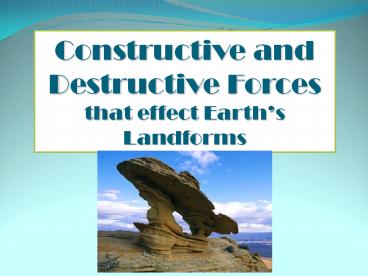Landforms and Oceans - PowerPoint PPT Presentation
Title:
Landforms and Oceans
Description:
Constructive and Destructive Forces that effect Earth s Landforms Weathering Weathering is the process that breaks down rocks at or near the surface of the earth. – PowerPoint PPT presentation
Number of Views:328
Avg rating:3.0/5.0
Title: Landforms and Oceans
1
Constructive and Destructive Forces that effect
Earths Landforms
2
- Weathering
- Weathering is the process that breaks down rocks
at or near the surface of the earth. - Weathering can be either physical or chemical.
- These processes cause the surface of the earth to
dissolve, decompose, and break into smaller
pieces.
3
- Weathering cont.
- Water is an important cause of weathering.
- Plants cause weathering when roots break apart
rock. (physical) - Changes in temperature can break rock, as well as
ice forming inside cracks in the rock causing it
to break even more. - Anything that causes rocks to wear down or break
apart is a cause of weathering.
4
- Erosion
- Erosion is the movement of sediments and soil by
wind, water, ice, and gravity.
5
- Deposition
- Deposition is the dropping, or depositing, of
sediments (soil, sand and minerals) by water,
wind, or ice. - Deposition builds up new land on Earths surface,
like a delta at the end of a river or the pile up
of a sand dune in the desert. - Shells on the beach are deposition by ocean
waves.
6
FORCES
- Constructive
- Processes that create landforms (deposition,
landslides, volcanic eruptions, floods)
- Destructive
- Processes that destroy landforms (weathering,
erosion, landslides, volcanic eruptions,
earthquakes, floods)
7
- Earthquakes
- Earthquakes are vibrations on Earths surface
caused by sudden movement in Earth, often along a
fault, a break in Earths surface. - Some earthquakes cause little damage and some
cause a lot of damage. - Large earthquakes can cause landslides.
- Earthquakes under the ocean can cause huge waves,
called tsunamis that destroy land and cause great
damage if they come ashore.
Tsunami
8
Earthquakes
These earthquakes created faults. Who can tell
me what a fault is?
9
- Volcanic eruptions
- Volcanoes are mountains with openings in Earths
crust through which magma, gases, and ash reach
Earths surface. - Volcanoes can change Earths surface.
- When the magma erupts from the volcano the top of
the mountain can be changed, either built up or
exploded off. - The lava and ash can destroy forests and bury
fields.
10
Volcanoes cont
- Volcanic eruptions can even change Earths
weather patterns. - Volcanic eruptions also occur under the oceans
these volcanoes that are built up are called
seamounts. - If the seamount rises above the ocean surface it
is called a volcanic island (for example Hawaii
or Japan).
Cooled magma creates solid landmasses
11
- Landslides
- Landslides are mass movements of land due to
gravity. - Landslides can cause buildings to fall, or power
and gas lines to break. - Landslides even occur on the continental slope in
the ocean.
12
Tsunamis
- Sometimes giant sea waves, called tsunamis, are
caused by underwater earthquakes, volcanic
eruptions, or landslides.
13
- Floods
- Floods occur when a large amount of water covers
land that is usually dry. - When the flood occurs, rapid erosion can take
place and move soil and sediments away. - When the flood recedes (goes away), new sediment
(dirt) is left behind and can build up rich soil
deposits.
14
Constructive vs. Destructive
Constructive Processes that create landforms Destructive Processes that destroy landforms
EXAMPLES Deposition Landslides volcanic eruptions Floods EXAMPLES Weathering Erosion Landslides Volcanic eruptions Earthquakes Floods
15
Deposition is a process that
- Dissolves sediment
- Breaks down rock to form sediment
- Removes sediment from landforms
- Drops sediment to form landforms
16
Where do deltas form?
- In desert areas
- At river mouths
- On the banks of rivers
- In valleys formed by glaciers
17
A river overflows due to excessive rains, and
floods surrounding areas. After the rain stops,
the water returns to the rivers original path.
However, the surrounding land is now covered with
new soil. This is an example of.
- A. deposition of sediment a
- destructive force
- B. deposition of sediment a constructive
- force
- erosion a destructive force
- erosion a constructive force
18
Volcanoes can create new land when they release
- Lava
- Water
- Gas
- Mud
19
What is weathering?
- A type of climate
- The transport of sediment
- The breakdown of rock
- The aging of rock
20
Tsunamis are caused by
- hurricanes
- a very large high tide
- underwater earthquakes
- the migration of whales
21
How do earthquakes change the land?
- They transport sediment.
- They form cracks in the surface.
- They release ash and lava.
- They cause chemical weathering.
22
Which is an example of deposition?
- acids that eat into rock
- wind building up sand dunes
- rivers wearing down mountains
- plant roots breaking apart rock
23
Which is not a type of physical weathering?
- Roots breaking rock
- Ice Breaking rock
- Wind and water
- Chemical Changes
24
What does erosion do?
- breaks down rock physically
- moves broken pieces of rock
- changes rock chemically
- change sediment into rock































